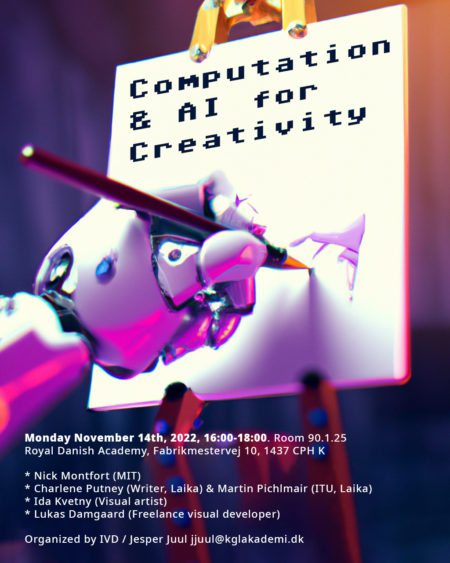I am organizing a seminar on Copenhagen this November 14th.
seminar on Copenhagen this November 14th.
Do new computational and AI tools for generating poetry, concept art, stories, and visual art fundamentally *change* creativity, and do they allow for new kinds of art?
In this seminar, open to all, five artists and writers share their process, results, and ideas about using computation and AI for creative work.
Monday November 14th, 2022, 16:00-18:00
Room 90.1.25, Royal Danish Academy, Fabrikmestervej 10, 1435 Copenhagen K.
We have five amazing speakers, each of which uses computation and AI for creative ends:
- Nick Montfort (MIT): “Computation and creativity in literature”
- Charlene Putney (Writer, Laika) & Martin Pichlmair (ITU, Laika): “Creating Laika, an AI tool for story writers”
- Ida Kvetny (Visual artist): “Using AI image generation as a visual artist”
- Lukas Damgaard (Freelance visual developer): “Building worlds using Midjourney”
Organized by Jesper Juul / Visual Game & Media Design / Institute of Visual Design at the The Royal Danish Academy
Info: jjuul@kglakademi.dk
Speaker Bios
Nick Montfort is a poet and artist using computation as his main medium. Computer-generated books of his include #! and Golem. The MIT Press has published his Twisty Little Passages, The Future, and Exploratory Programming for the Arts and Humanities. He directs a lab/studio, The Trope Tank, and is professor of digital media at MIT. He lives in New York City.
Ida Kvetny is an interdisciplinary artist based in Copenhagen, Denmark. Through VR, AR, NFT and AI Kvetny merges the digital with her works in paint and clay, and thus creates a multimodal visual world. Herein, the unconscious occupies a privileged space, where her intuitive approach to image creation leads to places unreachable by rationality.
Lukas Damgaard is a film animation director from the Danish Film School. He works as a freelance visual developer in the animation industry.

This seminar looks inspiring! How do I sign up?
There is no official sign up, but I note your interest in the event.
why not online?